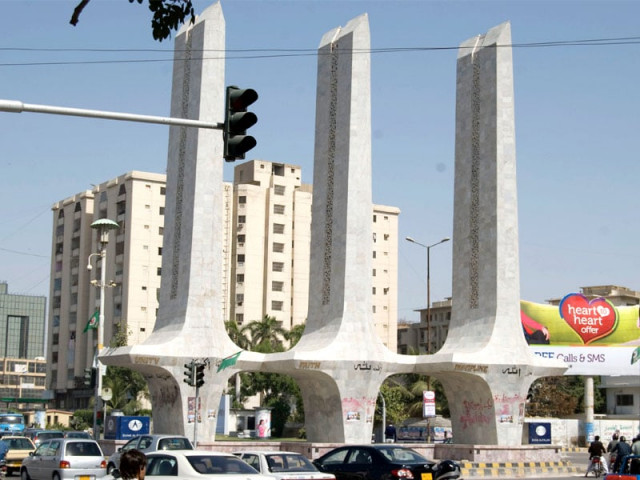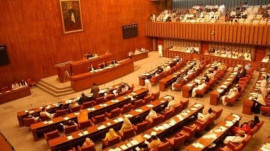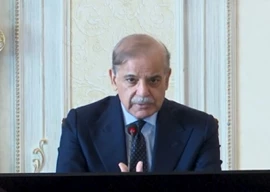
Unity, faith, discipline. These are the three words attributed to Quaid-e-Azam Mohammad Ali Jinnah. And they appear on the Three Swords monument, commissioned for Clifton by Zulfikar Ali Bhutto and designed by Parsi architect Minoo Pirozshaw Mistri aka Dada, in the 1970s. But along with these words, some creative and driven men have added other words, albeit in hastily sprayed red graffiti. Needless to say, these markings were not part of the original design.
Shortly after the red spray-paint appeared, it was scrubbed off, badly. This was not the work of the city government staff. They keep away from doing this kind of work, not because they are lazy, but because they are afraid.
“Sahib, take my job and throw me out but I will not do this,” said engineer Shakeel Memon with the road maintenance department in Saddar, while citing one of his staffers. “They don’t want to do this. Some of the employees have been beaten up as well.”
A couple of years ago, when a team from the Karachi Metropolitan Corporation (KMC) was sent to erase graffiti and white-wash over hateful sectarian slogans, the workers came back shaken and scared. Young men on motorcycles had intercepted the maintenance staff somewhere in Saddar and threatened them.
“We have a dilemma. Anyone can accuse us of blasphemy and shoot us dead,” Memon said. “You never know who is watching you.”
Not just the city staff, but those of Cantonment Board Clifton have faced the same problem. Their sanitation manager, Kabir Ali, agreed that no one wanted to take the risk, whether residents or staff. “People are never willing to have the walls repainted because they fear retaliation.”
Thus, the monuments and walls of Karachi, whether public or private, and especially along well-used roads have turned into a battlefield for sectarian turf wars. “Imagine being filmed while erasing the name of a religious figure,” pointed out Memon, while referring to the use of cell phones and their technology. “The video would spread like wildfire.”
And yet, half a dozen organisations, some of them banned, write and erase over each other’s work. In the case of Three Swords and its environs, supporters of one sectarian group wrote one slogan, which was erased and replaced with rival slogans. Whether it is for the Salmaan Taseer or Shahbaz Bhatti cases, Palestine, the Arab Spring or America, the flashpoints that dominate the news resurface as writing on the wall.
“You feel like we are fighting a foreign battle on our land,” remarks Ali Ahmer, a spokesman for the Jafaria Alliance. “But the truth is that this war was brought here years ago when a particular sect was allowed to dictate official policies and when internationally financed seminaries started to prop up everywhere.”
Ahmer claims that Ahle Tasheeh or Shia men retaliate with graffiti when the sect is maligned in similar acts. “It is reactionary. When a Shia is shot dead, [the] resentment is expressed like this.” II Chundrigar Road, Banaras, Quaidabad and Nazimabad are the hotspots for the tit-for-tat markings, he said.
“What you are seeing on Sunset Boulevard is reaction from one sect against another,” said Col (retd) Muhammad Amjad, the DHA’s vigilance director. “Last Muharram more than usual congregations were held in DHA. Now, the other sect is showing its muscle.”
Often, the hot-blooded men go one step further and gunfights break out. “The problem surfaces when some groups deliberately try to incite anger in our lower cadre,” said Sunni Tehreek’s coordination committee member Fahimuddin Sheikh, referring to a banned outfit. “The ST does not believe in sectarianism. Our graffiti mostly revolves around Eid Miladun Nabi.” He did not feel that there was anything wrong with using walls to express political or ideological views.
The city’s three major political parties remove graffiti from everywhere, he said. “But their focus was on the areas where we were in a majority,” Sheikh said. “They didn’t erase anything in their own strongholds.”
Several justifications are provided. Muhammad Zakiria, a student of the Khatm-e-Nabuwat Masjid, felt that it was not blasphemous to write the name of the Holy Prophet (PBUH) or his Companions on the walls, even if they could be erased. “We do believe that chalking on private property is illegal,” he explained. “Take our mosque, the Jamaatud Dawa people have inscribed slogans on its walls, which were painted recently.”
Taj Hanifi, the spokesman for the Ahle Sunnat wal Jamaat, former known as the Sipah-e-Sahaba, argued that graffiti is used to express respect. “It turns dirty when someone insults our leaders in wall chalkings,” he said before laying the blame on the city government. He did say that they were willing to agree to some code of conduct.
The practical Karachi Administrator Mohammad Hussain Syed seems to rise above the fray. He said that Pakistan was a free country and everyone was allowed to use the walls to express their faith. “Though it is illegal, you do realise the nature of this issue,” he tried to explain. “We try to remove the graffiti under cover of night, secretly and very cautiously.”
Published in The Express Tribune, February 26th, 2012.



1725254039-0/Untitled-design-(24)1725254039-0-270x192.webp)














COMMENTS
Comments are moderated and generally will be posted if they are on-topic and not abusive.
For more information, please see our Comments FAQ